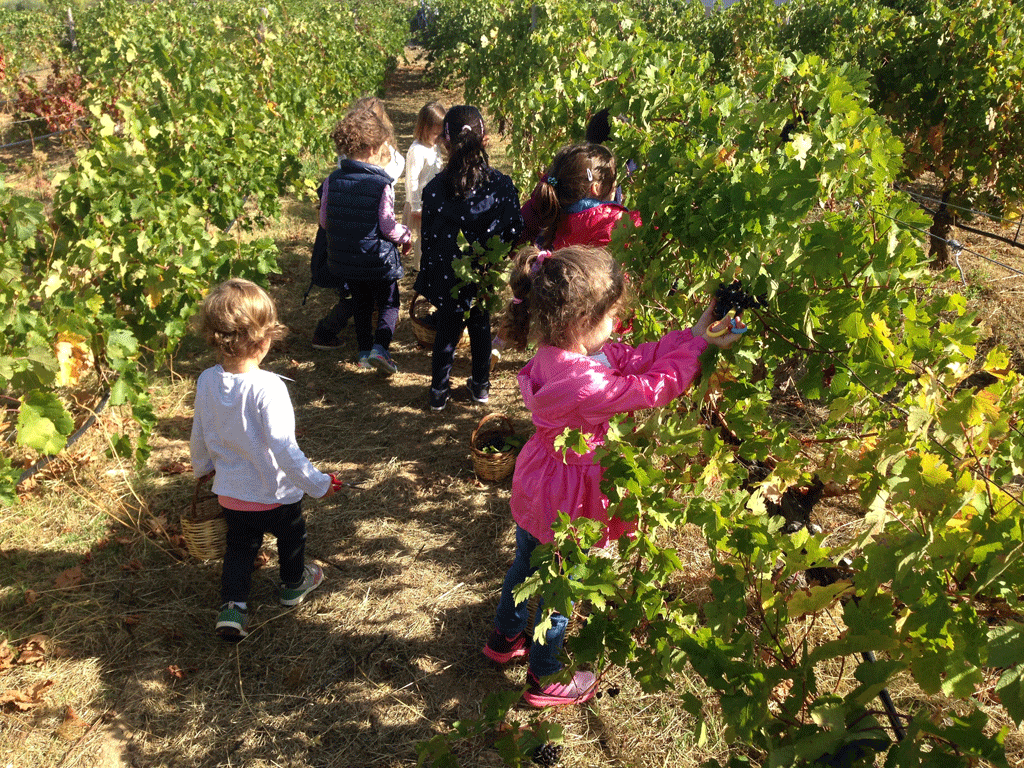Harvest Hands

Like itinerant workers, schoolchildren visit us throughout the autumn to learn about the harvest and get some hands-on experience.
Grape-picking happens throughout August and September, but there are always grapes left on the vine well into October (the ones that were not ripe at the time of harvest.) In Greek, these are called “koudounia” (bells), possibly because they are still on the vine when the bells on the animals can be heard returning to graze after the summer. This is when the children come as well. Having just settled into their new classes, their first outing is to participate in the grape harvest and the pressing of the grapes.

Before we begin, we become accustomed to the plants around us. Some children have never seen a vine before or may not know what it is. We observe the plant, the woody trunk, the leaves that have begun to change colour. We encourage the children to pull off the leaves and get a closer look. They look at them through a magnifying glass, marveling at the explosion of colours the autumn has brought in a single leaf. We then give them chalk to trace round them on the flagstone pavement. They discover the different shapes of leaf, depending on the variety: the rounded Chardonnay in contrast to the jagged Cabernet Sauvignon. We take a close look at the grapes attached to each, a white grape and a red one and we ask the question “Which one makes red wine?” The answer is pretty straight forward: “the red grape”. When it comes to white wine, they are always surprised (most adults as well) that both grapes can make white wine. The reason being that red wine gets its colour from the skin, whereas the juice is always clear. So you can make white wine from red grapes simply by removing the skins. At this point, the children get to squeeze the grapes between their fingers to see the colourless juice coming out.
It’s time for the harvest to begin. The children are given baskets and scissors, just like the workers would get crates and clippers, and set off down a row of vines, snipping off bunches of grapes as they go. Soon, their baskets are overflowing and they empty them into a crate to keep going. When we reach the winery, their cheeks are rosy, the baskets are full and it is with satisfaction that the children set down their crop and see how much they have managed to amass. We take a close look at the machinery in the winery. The destemmer removes the grapes from the stems, leaving a springy pile of stalks that’s good for climbing on. The grapes now travel up to the pneumatic press that fills its airbags with air to gently crush them and squeeze out the sweet grape must. The children get to do all this the old-fashioned way. We empty out the day’s vintage into a barrel we have cut and drilled a hole into. Socks and shoes are discarded and eager toes come out, ready to squash the grapes. There are always several bystanders as not all toes are so eager to get sticky! That means, plenty of helpers to tip in extra grapes and to collect the must trickling out of the hole. We collect this in a bottle and it goes back to school to be turned into “moustokouloura”, grape-must cookies.
We then walk through the rest of the winery, taking everything in: the tanks that echo when they’re empty; the wine cellar with the oak barrels that smell musky; the rattling bottling line. Here, the children are fascinated by the repetitive movement and get to take some self-adhesive labels home with them. Before they go, there is just enough time for a picnic on the grass, where they can relax in the sunshine and munch on a grape-must cookie.






























